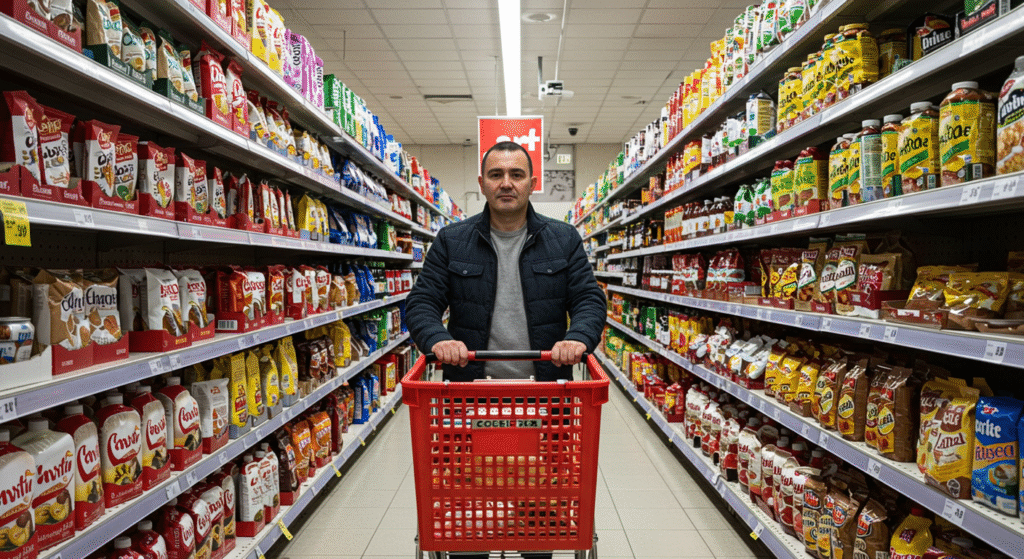Grocery prices in 2025 feel steeper than ever, with inflation driving up the costs of basics from eggs to bread. Nearly every trip to the store leaves me searching for ways to stretch my budget further, and I know I’m not alone. Shoppers are spending nearly a third more on food compared to just a few years ago, putting real pressure on families and singles alike.
But high prices don’t have to drain your wallet. With smart budgeting and a few practical shifts, it’s possible to save money on groceries without giving up quality or taste. In this guide, I’ll show how to cut costs, make healthier choices, and put more of your hard-earned cash back in your pocket no matter how busy your week gets.
Why Smart Grocery Budgeting Matters

Every dollar spent at the checkout counts more now than ever. The uptick in food prices keeps nudging family budgets up, making it clear why having a smart approach to grocery budgeting isn’t just helpful it’s essential. Grocery inflation shows no signs of letting up. Without a clear plan, the stresses at the grocery store can spill over into weekly routines, health choices, and financial wellbeing. By getting intentional about how we plan, shop, and track spending, it’s possible to take back control. Let’s break down exactly why smart budgeting matters so much this year.
How Rising Food Prices Affect Families
The grocery bill has become a stress test for wallets across the country. According to the USDA’s latest summary, prices for all foods are predicted to rise about 2.9 percent in 2025. Some regions feel it even more, with urban areas like Philadelphia seeing spikes of over 7 percent, while certain rural communities face food inflation of nearly 8 percent.
These changes show up in monthly spending:
- The average American adult now spends about $350 per month on groceries.
- For a family of four, that total often reaches $750 a month. That’s up nearly a third compared to just a few years back.
- Protein-rich foods like beef, poultry, and eggs have risen most sharply, with some stores charging 8-10 percent more for meat and up to 40 percent more for eggs, driven by disease outbreaks and ranching challenges.
- While produce prices in areas like California are stabilizing or even dropping (down 6 percent in some cases), the majority of Americans still face regular sticker shock, especially on packaged goods, bread, and staple grains.
Food insecurity mirrors these jumps. Low-income families, already strained, now spend as much as 30 percent of their income on groceries—more than double the national average. As of early 2025, food insecurity rates in the US have ticked up toward 13 percent of households, with big cities and rural regions hit hardest.
Quick Comparison Box: Regional Grocery Inflation (2025)
| Region | Inflation Rate | Typical Family Spend (Monthly) |
|---|---|---|
| Urban Metro (PA) | 7.1% | $780+ |
| National Avg. | 5.3% | $750 |
| Rural Midwest | 7.6% | $800+ |
| Colorado | 2.9% | $690 |
Squeezed by rising prices, families must make tough choices—scaling back on favorites, opting for store brands, or skipping healthy foods. That’s exactly where budgeting comes in.
The Benefits of a Budget-First Approach
Building a grocery budget isn’t about penny-pinching every meal or surviving on ramen noodles. It’s about clarity and control. Here’s what happens when you put your plan first:
- Less Waste: When you shop with a list and a spending cap, impulse purchases sink, and less food lands in the trash at home.
- Better Use of Sales: Tracking weekly flyers or using loyalty programs keeps you focused on what’s truly a deal not just what’s eye-catching at the shelf.
- Healthier Choices: When the essentials are planned in, it’s easier to skip the filler foods and make room for fruits, veggies, and proteins.
- Long-term Savings: Consistency compounds. Even shaving $20 a week off your grocery haul adds up to over $1,000 each year money back in your wallet for other goals.
A budget acts like a roadmap, turning chaotic shopping into a simple routine. Think of it as having lane lines on a busy road. Instead of weaving through distractions and last-minute decisions, you’ve got a route and a destination you trust.
Quick Benefits Checklist: What You Gain With a Smart Grocery Budget
- Lower stress at checkout
- Fewer “mystery items” in your pantry
- More predictable grocery totals
- Flexibility for treats, without guilt
- Room for meal planning and batch cooking
By setting your own guardrails before walking into the store, you give yourself the power to keep food affordable, reduce daily stress, and support better eating habits for everyone at your table.
Building a Smart Grocery Budget: Steps and Tools

Finding new ways to save money on groceries starts with knowing exactly where every dollar goes, planning ahead, and using the right tools to stick to your goals. Even with food prices rising in 2025, it’s possible to stretch your budget while keeping your kitchen stocked with everything you need. Let’s look at how to track spending, set the right budget, plan your meals, and supercharge your shopping routine with some of the best tips and tools out there.
Tracking Your Spending Habits
If you don’t know what you’re spending, it’s easy for small trips and impulse buys to wreck your monthly plan. Keeping track of grocery expenses gives you a clear picture of where your money actually goes. This isn’t just about receipts modern tracking tools deliver insights you just can’t get from a single shopping slip.
Popular apps for tracking grocery expenses in 2025:
- YNAB (You Need a Budget): Assigns every dollar a job and syncs with your bank, ideal for disciplined budgeting.
- EveryDollar: Simple, manual entry or automatic bank syncing, perfect for quick inputs.
- Mint: Brings together all expenses across accounts and tracks spending patterns with minimal effort.
- Banktrack: Real-time transaction tracking, customizable dashboards, and predictive analytics.
- Receipt Hog: Rewards you for scanning grocery receipts with cash back and points.
If you prefer spreadsheets, check out free templates from Tiller or Google Sheets. These let you break down your spending by week, store, or even food group. Spend ten minutes each week logging your receipts or checking your app dashboard, and you’ll soon spot patterns like impulse spending or sneaky rising costs.
Setting a Realistic Grocery Budget
A budget that’s too strict won’t last; too loose, and you’ll lose track before the month is out. To build a sustainable grocery plan, start by reviewing your past expenses. Open your bank statement and add up every supermarket, convenience, and online food order from the past few months.
Then, factor in these points:
- Income: Experts suggest allocating around 10–15% of your monthly take-home pay to groceries. The average U.S. household now spends close to $504 a month, but your own number may vary.
- Family size: A single person will spend less than a family of four. Larger households can save with bulk buying, but overall totals will be higher.
- Dietary needs: Special diets (like gluten-free or plant-based) can mean more expensive staples. Look for ways to substitute or buy in bulk when possible.
- Your priorities: Maybe you always want fresh berries or grass-fed beef. Budget for these splurges, but balance them out elsewhere.
Check out the USDA’s four monthly “Food Plans” as a frame of reference, from Thrifty to Liberal. Adjust your target up or down, then revisit every three months and make small tweaks as your needs shift.
Planning Meals and Shopping Lists
Meal planning isn’t just for food bloggers it’s the heart of the smart grocery budget. When you plan your meals in advance, you only buy what you’ll eat and waste far less.
A strong meal plan brings several advantages:
- Reduces food waste: No more forgotten spinach or extra hamburger buns sitting in the back of the fridge.
- Streamlines shopping: A complete list saves time and money, leaving little room for impulse buys.
- Covers nutrition: Planning ahead helps balance meals and ensures you always have what you need.
Start by checking your pantry and fridge, then sketch out a week’s worth of breakfasts, lunches, and dinners. Cross-check what you already have and create a precise shopping list based on gaps. I like to keep my list sorted by store sections produce, dairy, frozen to speed up trips and prevent accidental splurges.
Quick Tips for Smarter Grocery Shopping
Here’s a handy 3-column box with fast strategies for anyone looking to optimize each grocery trip. Compare prices, find digital savings, and make the most of sales for lasting results.
| Ways to Compare Prices | Apps to Find Savings | Stocking Up on Sale Items |
|---|---|---|
| – Check price per unit or ounce | – Ibotta for instant cash back | – Buy non-perishables in bulk |
| – Compare in-store and online ads | – Honey for automated coupons | – Freeze proteins and bread |
| – Use loyalty rewards for discounts | – Flipp to browse local flyers | – Stock up on staples only when a big discount hits |
Knowing these tactics can immediately stretch your monthly budget, without extra work. Getting the most value from every grocery run comes down to having a system in place and sticking with it.
Essential Strategies to Save More at the Store

Constant changes in food prices and weekly deals mean getting the most from your grocery budget takes more than just clipping a few coupons. I’ve learned that by timing when and how I shop, looking closely at what I buy, and taking advantage of store technologies, I can reliably spend less every month without sacrificing nutrition or my favorite foods. Here’s how these core strategies can help you save money on groceries with smart budgeting.
Timing and Shopping Smart
Shopping during the right window makes a bigger difference than most people think. In 2025, most grocery stores run their sales cycles on a regular schedule, with deep discounts popping up every six to twelve weeks. Tracking these cycles lets you buy pantry staples, proteins, or seasonal produce at their lowest prices. I use this system to stock up on things like pasta, coffee, or canned goods when prices drop, then skip them until the next cycle.
Grab a copy of your store’s weekly flyer like Safeway’s, Whole Foods Market’s, or Market Basket’s to spot these sale patterns. I see summer drinks and fresh fruits go on sale from late May, while grilling meats hit their lowest just before Memorial Day or July 4th. Loading up while these deals are hot keeps my meals fresh and interesting without overspending. Shopping during off-peak hours (early mornings or late evenings) also pays off, making it easier to spot markdowns and move through the aisles faster.
A few habits to make the most of timing:
- Keep physical or digital sale flyers for at least one cycle. Compare prices.
- Set reminders on your phone to check for new promotions each week.
- Plan shopping trips right after new deals launch on Wednesday or Thursday, before popular sale items run out.
Bulk Buying and Private-Label Products
Buying in bulk can be smart, but it pays to do the math. Not every “jumbo pack” will save you more per unit, especially for perishable foods. Dry goods like rice, dried beans, oats, and nuts can be a great bulk buy with long shelf lives. When I see these staples at their bottom price during a sale, I aim for a two- or three-month supply, but stay realistic about what I’ll use before it goes stale.
Private-label or store brands are growing fast in 2025, taking over more shelf space. These often offer a savings of 10 to 30 percent over brand-name products, with quality that stacks up. I’ve found store-brand peanut butter and pasta to be nearly identical, but a fraction of the price. Roughly 20 percent of what shoppers put in their carts now comes from private labels.
Tips for smart bulk and private-label savings:
- Only buy perishables like dairy or meat in bulk if you can freeze or use them within a week.
- Compare the price per ounce or pound between bulk and regular-size packages.
- Test store brands a few items at a time. Swap out basics like canned tomatoes, cereal, or snacks.
Technology at the Checkout: Apps, Rewards, and Cashback
Gone are the days of only paper rewards. Most stores now offer robust digital tools that directly lower your bill. I always download my grocery store’s app to access digital coupons, notification of sale events, and app-exclusive prices. Programs like Safeway’s Club Card, Whole Foods’ Prime Member deals, or Kroger’s loyalty points put instant savings at your fingertips.
Cashback apps like Ibotta, Fetch, and Checkout 51 reward you simply for scanning receipts or buying promoted brands. These rewards add up fast, and I regularly earn back $10–$30 a month with just a little engagement. Many cards and digital wallets let you stack these perks think using your loyalty card, digital coupon, and a cashback app on one transaction.
Concrete steps to boost savings with tech:
- Link your loyalty card in each store’s app and activate digital coupons before shopping.
- Use Flipp or Basket apps to compare weekly ads across chains for the best current deals.
- Scan every grocery receipt for cashback with apps like Ibotta or Fetch.
- Check for exclusive in-app flash sales or rewards programs that give discounts for frequent shoppers.
Mistakes That Blow Your Grocery Budget
Shopping mindfully means avoiding some common traps. Here’s a quick visual box three big mistakes and how to fix them fast:
| Impulse Buying | Overlooking Unit Prices | Shopping Hungry |
|---|---|---|
| Tossing in “extras” you don’t need. | Ignoring price-per-ounce or pound. | Buying more (and less healthy) when hungry. |
| Fix: Stick to your list. Give yourself one treat limit. | Fix: Always check the shelf tag unit price and compare across brands/sizes. | Fix: Eat a snack before shopping, or shop right after a meal. |
Recognizing these pitfalls and planning for them can lead to big improvements over time. Little habits truly add up when you’re looking to save money on groceries with smart budgeting.
By timing your trips, shopping sales cycles, taking advantage of in-store brands, and using every tech tool available, you can take real control of your food costs while eating well.
Common Grocery Budgeting Mistakes and How to Avoid Them

Smart budgeting means more than just writing down your grocery list. It’s easy to slip up and let well-made plans get lost under bright store lights or busy weeks. These slip-ups can quietly drain money from your wallet, often without you noticing at first. Addressing common mistakes head-on helps you get the most value from every dollar and keeps your grocery budget on track. Here’s what I’ve learned, and how you can sidestep these typical hurdles.
Impulse Purchases and List Fatigue
Even the best grocery intentions can fall apart once you hit those tempting aisles. Impulse purchases are a major culprit behind busted grocery budgets. We start strong, armed with a list, but end up tossing extras into the cart cookies by the checkout, a box of cereal not on the list, or “just one more” frozen dinner.
Why do so many of us abandon our lists at the store? Here’s what I see most often:
- Store layout is designed for detours. Products you don’t need show up at eye level or near entrances.
- Shopping while stressed or hungry lowers willpower.
- List fatigue—the sense that sticking to the plan is too much work after a long day.
The result? The final bill creeps much higher than planned.
How I stay focused and motivated:
- Keep a running list: Add items as you run out, using your phone or a note on the fridge.
- Organize the list by store section: Group together produce, dairy, meat and pantry. You’ll spend less time and avoid unnecessary aisles.
- Set a treat limit: Allow yourself one unplanned purchase each trip to keep things flexible but controlled.
- Eat before you go: Shopping hungry almost always leads to extra spending.
- Stick to your route: Shop the outer sections of the store first, where fresh basics are, then check your list before entering “treat” zones like snacks and baked goods.
A little discipline here saves a lot over time. Lists work best when you make them your ally, not your enemy.
Letting Good Food Go to Waste
Food waste is like tossing money straight into the trash. Even with a tight list, food that spoils or gets forgotten can eat up a chunk of your budget.
Here’s where most of the waste happens:
- Buying more fresh produce than you can use
- Losing track of leftovers at the back of the fridge
- Poor food storage habits
The good news: a few small shifts can rescue those lost dollars.
How I cut my food waste (and keep my budget happy):
- Plan for leftovers: Design meals that create extras for lunches, or use last night’s chicken in a salad or soup. Leftovers are just ingredients in disguise.
- Store food properly: Learn how to store each type of produce. For instance, keep fresh herbs in a jar of water or wrap greens with a paper towel in a bag.
- First in, first out: Put new items under or behind older ones so you use them up before they spoil.
- Freeze what you can: If produce is about to turn or you made too much soup, stick it in the freezer you control how much you waste.
Cutting down waste takes a little planning, but the payoff is instant: less money tossed out and a fridge stocked with ready-to-go meals.
Falling for ‘Deal’ Traps

Not every deal you see on the shelf is a real bargain. Stores spend a lot of time and effort finding ways to tempt you into buying more than you need.
Common “deal traps” that I see all the time:
- Endcap displays: Products stacked at row ends often look like they’re on a big discount, but sometimes are only marked down a few cents or not priced lower at all.
- ‘Buy more, save more’ deals: You might buy three boxes to get the deal, even if you only need one. This can lead to wasted money (and sometimes wasted food).
- Bulk bins and family-size packages: The price per unit isn’t always lower. Always compare the shelf tags for the real cost per ounce or pound.
Here’s how to sidestep these traps:
- Check unit prices: Always look at the unit or per-ounce price on the shelf tag before grabbing the sale item.
- Only buy deals you’d use anyway: If it’s not on your list, question if it’s truly a savings, or just a temptation.
- Don’t let the packaging decide: Bigger isn’t always better. Buy what you know you’ll use and store in time.
Staying sharp with store deals means you get the real savings and none of the budget-wrecking extras.
When you avoid these common mistakes, your grocery dollars stretch further, your kitchen stays full, and you shop with confidence, not regret.
Conclusion
Small shifts in the way I budget, plan, and shop have opened the door to real freedom with my money and my meals. By sticking to a smart system, paying attention to sales, and putting a little extra care into meal prep and storage, I’ve watched my grocery spending stay steady even as prices climb.
The tips and tools in this guide prove that saving money on groceries with smart budgeting doesn’t have to be complicated or stressful. It’s the collection of simple habits checking flyers, making a thoughtful list, choosing store brands, and avoiding impulse buys that adds up to meaningful change over time.
If you’ve found these ideas helpful, share your own wins or favorite saving tricks in the comments below. I’d love to hear how you’re stretching your grocery dollars this year. Don’t miss out on more budget-friendly advice follow the blog for fresh tips and strategies to help you save money on groceries and feel confident about your budget each month.
Take action today pick just one new habit from this article and try it on your next grocery run. Every smart choice brings you closer to a less stressful, more rewarding routine in the kitchen and beyond. Thanks for reading and for choosing to be intentional with every dollar you spend.





